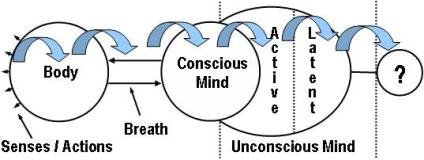Mahavakyas (great contemplations)
http://www.swamij.com/mahavakyas.htm
STAGES OF YOGA VEDANTA MEDITATION AND CONTEMPLATION
Swami Rama
Meditation and contemplation are two different techniques, yet they are complementary to each other. Meditation is a definite method of training oneself on all levels – body, breath, conscious mind, and unconscious mind – while contemplation builds a definite philosophy. Without the support of a solid philosophy, the method of meditation does not lead to higher dimensions of consciousness.
Contemplation makes one aware of the existence of the Reality, but Reality can be experienced only through the higher techniques of meditation. In the Vedanta system, meditation and contemplation are both used. When an aspirant tires of meditation because of lack of endurance, then he contemplates on the mahavakyas [great contemplations] and studies those scriptures that are helpful in the path of Self-realization and enlightenment. Contemplation, vichara, complements the Vedantic way of meditation, dhyana.
In Vedanta philosophy, there is a definite method used for contemplation. Ordinarily, the mind remains busy in self-dialogue, entangled in the web of its thought patterns. Because of desires, feelings, and emotions, unmanageable conflicts are created in one's mental life. But the Vedanta way of contemplating transforms the entire personality of the aspirant, for the statements, mahavakyas, imparted by the preceptor create a dynamic change in the values of his life. These statements are compact, condensed, and abstruse srutis and cannot be understood without the help of a preceptor who is fully knowledgeable of the scriptures and these terse texts. Only a realized teacher can impart the profundity of such knowledge in a lucid language.
The thoughts, feelings, and desires which were once important to the aspirant lose their value, for he has only one goal to attain. The glory of contemplation brings a dynamic transformation to the internal states of the aspirant. This seems to be very necessary, because that which creates a barrier or becomes an obstacle for students loses its strength due to the power of contemplation, which transforms all his internal states.
First, an aspirant attentively listens to the sayings of the Upanishads from a preceptor who is Brahman-conscious all the time.
In the second step, he practices vichara (contemplation), which means that he goes to the depths of the great sayings and determines to practice them with mind, action, and speech.
One-pointed devotion, full determination, and dedication lead him to the higher step called nididhyasana. Here he acquires comprehensive knowledge of the Ultimate Truth. But he has not yet attained the final step of consciousness that leads him to the direct realization of the one self-existent Truth without second.
The highest state of contemplation is called saksatkara. In this state, perception and conceptualization are in complete agreement, and all the doubts from all levels of understanding vanish forever. At this height of knowledge, truth reveals itself to the aspirant, and perfect realization is accomplished, "I am Atman – I am Brahman." This state of advaita is attained by the process of contemplation. Meditation plays an entirely different role and helps the aspirant make his mind one-pointed, inward, and steady.
Steadiness and stillness are practiced from the very beginning in this meditational method. The method of sitting, the method of breathing, the method of concentration, and the method of allowing a concentrated mind to flow uninterruptedly are subsequent steps that help the aspirant to expand his capacity so that he can contemplate without distraction.
Attaining Yoga or Union:

Yoga or "Union" is attained by first training, balancing, and purifying each of the aspects of our being individually, and then systematically receding attention inward through those levels, expanding so as to experience the state of Union, Yoga, Samadhi, or Turiya.


